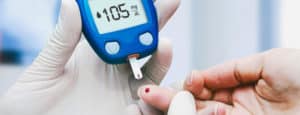Difference between Type-1 and Type-2 Diabetes
There are two main types of diabetes, i.e., type-1 diabetes and type-2 diabetes. Both of these types are a part of chronic illness that ultimately affects how your body controls and regulates blood sugar levels (glucose). Glucose is the energy that the body needs to carry out routine functions, but it needs insulin to do that.
Type 1 diabetes is also called insulin-dependent diabetes. In this condition, the body is unable to produce insulin.
Type 2 diabetes is also called adult-onset diabetes. In this condition, the body is unable to respond to the production of insulin as well as it should.
Symptoms
The symptoms of type 1 diabetes are often sudden and are characterized as:
- Frequent urination
- Frequent hunger
- Frequent thirst
- Unintentional weight loss
- Mood changes and irritability
- Weakness and constant fatigue
- Blurry vision
Signs and symptoms of type 2 diabetes often develop and appear slowly as compared to type 1 diabetes. It means that you can have this condition for years and still have no clue about it. Some of the common indications of type 2 diabetes are:
- Increased hunger
- Increased thirst
- Frequent urination
- Cuts and sores that are unable to heal properly
- Recurrent infections
- Numbness and tingling in hands or feet
- Certain areas of skin may become dark such as neck and armpits
Causes
Though the exact cause is still unknown, many studies claim that type 1 diabetes usually occurs when a person’s immune system and his/her body fighting the infections and viruses start attacking and destroying the insulin-making beta cells in the pancreas. Most of the researchers believe that type 1 diabetes can also develop due to genes and certain environmental factors like bacteria and viruses.
- Physical Inactivity and Obesity
People are more likely to develop type-2 diabetes if they are not physically very active and are too overweight. Obesity can lead to insulin resistance; especially belly fat is directly linked to insulin resistance, diabetes, and heart diseases.
- Insulin Resistance
Sometimes, the liver cells and muscles are unable to use up insulin very well. As a result of this, the pancreas starts taking up more insulin to keep up with the body demand. Over time, the pancreas becomes less functional and unable to produce any insulin at all, which in turn increases the blood sugar level.
- Family History and Genes
Diabetic family history or genes means that you are at a high risk of developing type-2 diabetes. This disease tends to run in the family and may occur more frequently in some racial/ethnic groups like African Americans, American Indians, Latinos/Hispanics, Asian Americans, and Alaska Natives.
Complications
Over an extended period, type-1 diabetes can also affect vital organs in the body that may be disabling or life-threatening. Some of the complications of type-1 diabetes are:
- Heart and blood vessel disease (increased risk of cardiovascular problems such as coronary artery disease, angina, chest pain, atherosclerosis, high blood pressure, and stroke.
- Nerve damage or neuropathy (numbness, tingling, burning pain that starts at the tip of fingers or toes and gradually spreads in the entire body)
- Kidney damage or nephropathy (kidney failure or end-stage kidney disease)
- Skin and mouth condition (infections of mouth and skin such as bacterial and fungal infections)
- Complications in pregnancy (risk of miscarriage, stillbirth, and congenital disabilities)
Type-2 diabetes, on the other hand, can easily be ignored, particularly during the early stages. But, if left untreated, it can lead to severe complications like:
- Heart and blood vessel diseases
- Nephropathy
- Neuropathy
- Eye damage (serious eye diseases like glaucoma or cataract)
- Slow healing (blisters and cuts become infected that may heal poorly)
- Hearing impairment
- Skin problems (bacterial and fungal skin infections)
- Sleep apnea
- Alzheimer’s disease
Diagnosis
Diagnostic tests for type-1 diabetes are:
Random Blood Sugar Test
Random blood glucose test can be conducted at any time of the day and assessed through repetitive testing. A blood glucose level of more than 200 mg/dL or 11.1 mmol/L indicates diabetes. These values are always coupled with two primary symptoms of diabetes, i.e., frequent urination and frequent thirst.
Fasting Blood Sugar
After overnight fasting, a blood sample is withdrawn and assessed. A fasting blood sugar from 100-125 mg/dL is considered as a pre-diabetic condition, and if it is 126 mg/dL or more, it is considered diabetes.
Diagnostic tests for type-2 diabetes are:
- Random Blood Sugar
- Fasting Blood Sugar
- Glycated Hemoglobin (A1C Test)
Through this test, the doctors determine the blood sugar levels of a person for the past two to three months. The normal range is below 5.7%; results between 5.7-6.4 are considered pre-diabetes, while 6.5% or higher levels indicate type-2 diabetes.
- Oral Glucose Tolerance Test
The patient fasts overnight and drinks a sugary liquid at the time of the test. For the next two hours, the doctors assess the blood sugar levels periodically.
Treatment
Treatment options for type 1 diabetes include:
- Carbohydrate, fat and protein counting
- Taking insulin (short-acting insulin, rapid-acting insulin, intermediate-acting insulin, and long-acting insulin)
- Medications (aspirin, cholesterol-lowering drugs, and high-blood pressure medications)
- Consume healthy foods like fruits and vegetables
- Frequent blood sugar monitoring
- Regular exercising
- Maintaining a healthy weight gain

Treatment options for type-2 diabetes include:
- Weight loss
- Healthy and proper diet
- Regular exercise
- Regular blood sugar monitoring
- Diabetes medication or insulin therapy (Glucophage, sulfonylureas, a thiazolidinedione, and SGLT2 inhibitors.

Prevention
There is no particular way to prevent type 1 diabetes. However, the researchers are still working on techniques that can either prevent the disease or restrict further destruction of the islets cells in people who have been recently diagnosed.
To prevent type 2 diabetes and its related complications, you can opt for healthy lifestyle choices like:
- Eating healthy foods (fruits, vegetables, and foodstuff that are high in fiber)
- A minimum 30-40 minutes workout every day, 15 minutes of vigorous aerobic activity, brisk walking or bike riding
- Try to lose 10-15 percent of your body weight to reduce the risk of developing type 2 diabetes
- Avoid standing still for long periods; try to get involved in some activity every 30 minutes. It is recommended to move around for a couple of minutes every hour.
Call Achira Endocrinology and Weight Loss Clinic at 313-600-4669 to Schedule an appointment to learn more about how Dr. Achira Can help you. Click here to Contact us. Click here to schedule an appointment on Healow.





